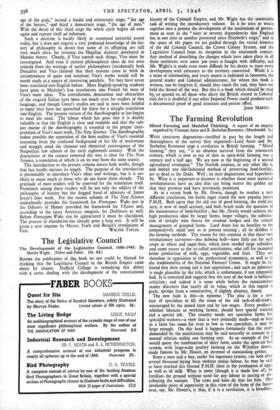The Farming Revolution
WITH consistent dogmatism—justified in part by the length and thoroughness of the survey they organised—Lord Astor and Mr. Seebohm Rowntree urge a revolution in British farming. " Mixed farming," they say, " is an obsolete survival from the nineteenth century, which is now as out of date as open-field farming was a century and a half ago. We are now at the beginning of a second agricultural revolution." The Norfolk rotation, or any other like it, and indeed any old-fashioned method of preserving land-fertility, are as dead as the Dodo. Well ; let their dogmatisms and hyperboles be. What it is important to discover is whether these most statistical revolutionaries have an idea that can bring nearer the golden age that they promise and have previously promised.
As in a recent book by Mr. Orwin, though he reaches a very different conclusion, the battle rages round the now popular letters P.M.H. Both agree that the old test of good farming, the yield per acre, is now of small account, and both brush aside the question of the maintenance of land-fertility; but Mr. Orwin would achieve the high production ideal by larger farms, larger villages, the substitu- tion of straight wire fences for crooked hedges and the central management of grouped farms. Lord Astor has no hostility to the comparatively small unit as at present existing ; all he dislikes is the farming methods. The reason for this contrast is that these two revolutionary surveyors—duo fulmina belli—have little use for such crops as wheat and sugar-beet, which have needed large subsidies, and come nearer to the so-called nutritionists, who call for increased home production of milk, eggs, vegetables and fruit. They are therefore in opposition to the professional economists, as well as to the traditionalists of the National Farmers' Union. It might be in- ferred that their strong suit is just opposition ; and such an inference is made plausible by the title, which is unfortunate, if not inherently bad. It is conceited and suggests that the core of the book is bellicose criticism; and indeed it is some while before the conscientious reader discovers that nearly all its value, which in this regard is great, springs from a constructive, if slightly abstract, theory. The new faith is this—in epitome. The plea is fot a new race of specialists to fill the room of the old jack-of-all-trades, encouraged by the mixed farm and by low wages. Every producer, whether labourer or working farmer, should have special training and a special job. The country needs not specialist farms but specialist workers—a view that is very pointedly made—and so long as a farm has room for even as few as two specialists, it may be large enough. On this head it happens fortunately that the crops demanded by the nutritionists may be said naturally to consent to a mutual relation within one fanning unit. As an example of this I would quote the combination of dairy farm, under the open-air bail system, with large-scale poultry farming on the Wiltshire downs, made famous by Mr. Hosier, an inventor of outstanding genius. Since a man and a boy, under his ingenious system, can look after several thousand laying hens without undue labour, he may be said to have reached this blessed P.M.H. ideal in the production of eggs, as well as of milk What is more (though it is made less of), he fertilises the ground without need for any labour in storing or dis- tributing the manure. The cows and hens do that for him. One invaluable point of superiority in this view of the farm of the future over, say, Mr. Orwin's, is that, if it is a revolution, it is bloodless.
It involves no destruction, no important material changes. The land may remain unnationalised, the hedges undestroyed, and the villages undisturbed. Given a supply of such specialised workers, fewer men could be used without diminution of the yield per acre. Practical suggestions for bringing this change to pass are a little sketchy, and might well have been substituted for pages of misleading statistics. It is virtually useless to compare British P.M.H. figures with American. This reviewer was amazed, when staying on Argen- tine stations, to find at how low a price cattle could be sold and yet yield good profit. The chief reasons wer immensely wide acres, and the entire absence of distribution troubles, and immediate pay- ments. To compare either North or South American P.M.H. figures with ours is as nearly as may be meaningless, where it is not mis- leading. Again, it is a form of jargon to urge that " the attempt can and must be made to publicise P.M.H." After all, P.M.H. only means that a farm should make profit enough to warrant good wages, an obvious general truth that needs no governmental publicising. The mistaken style of proclaiming the result of this wholly admirable survey is the more regrettable as the main thesis, so authoritatively documented, might well promote a most beneficent revolution or, better, evolution ; for, after all, the mixed farms, so called, that these alleged revolutionaries condemn -have already progressed a long way towards the newer ideal. The now popular ley has already scotched the old systems of rotation. How many people spend needless labour































 Previous page
Previous page